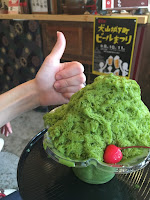 One of the first things that I learned about Japan was that this county LOVES food! And, on most days smells like food too! Without looking at the clock, I can tell when it's 5:30pm as the smell of soy sauce in one form or another comes wafting up through the vents of our apartment complex.
One of the first things that I learned about Japan was that this county LOVES food! And, on most days smells like food too! Without looking at the clock, I can tell when it's 5:30pm as the smell of soy sauce in one form or another comes wafting up through the vents of our apartment complex.
Japanese culture definitely centers around food. Everywhere you go - there is food! Whether it be at restaurants, combinis (convenience stores), roadside stands, etc. Gifts given are most commonly food; and, Japanese airlines even serve you a meal on a 45-minute domestic flight!! And, even if the shop is the size of your closet and looks extremely rundown and grimy - you can count on the food being tasty...otherwise people wouldn't eat it and the shop wouldn't exist!
 There are more restaurants in Japan than anywhere else I've visited thus far...and most of the restaurants look to hold a maximum of 15 people - tops! I've often wondered - and often been asked - how do all of these places stay in business? In Japan, it seems as though restaurants specialize in certain types of food...and so people will seek out a certain restaurants when they want a certain type of food. And, I don't just mean going to an Italian restaurant because you're craving Italian food or an Indian restaurant because you're craving Indian food. I mean...craving noodles and having to decide between going to a restaurant that serves udon noodles, soba noodles, or ramen noodles because you can't get all three in one place. Sure, there are chain restaurants here - and places that serve a variety of Japanese foods for you to choose from; however, when you want a certain food - it's best to go to a place that serves just that!
There are more restaurants in Japan than anywhere else I've visited thus far...and most of the restaurants look to hold a maximum of 15 people - tops! I've often wondered - and often been asked - how do all of these places stay in business? In Japan, it seems as though restaurants specialize in certain types of food...and so people will seek out a certain restaurants when they want a certain type of food. And, I don't just mean going to an Italian restaurant because you're craving Italian food or an Indian restaurant because you're craving Indian food. I mean...craving noodles and having to decide between going to a restaurant that serves udon noodles, soba noodles, or ramen noodles because you can't get all three in one place. Sure, there are chain restaurants here - and places that serve a variety of Japanese foods for you to choose from; however, when you want a certain food - it's best to go to a place that serves just that!
I've come to realize through our travels over the past few years that enjoying a city or country's food is an absolutely amazing way to really experience the place you are visiting! And, if you do some research beforehand - you'll find that specialty dishes exist just about everywhere you go! Up until about 10 years ago, I don't think I enjoyed food nearly as much as I do now. Nor was I nearly as willing to try new foods either!
As I could write numerous posts on food culture in Japan, I've been brainstorming about this post for some time. And, I've decided that it might be neat to both paint a picture of what "eating out" looks like in Japan (i.e., the foods that we tend to introduce to our visitors when they enroll in "Kaz's Japan Food Tour!!") and also talk a bit about what normal "everyday eating" looks like too!
Breakfast
 |
| Traditional Japanese breakfast |
 For a cereal lover like me, breakfast was a bit of adjustment. While Japan does have cereal - there are about four kinds tops...and it's usually eaten as a snack or dessert. I can't tell you how many times my cup of ice cream had a little bit of cereal at the bottom. The cereals resemble Rice Krispies, Corn Flakes, Coco Puffs, and then something that literally looks like a combination of all three! So - my normal breakfast usually involves a smoothie, yogurt and fruit, toast, or cereal. Kaz sometimes eats rice, fish, and miso soup; however, not when in a time crunch!
For a cereal lover like me, breakfast was a bit of adjustment. While Japan does have cereal - there are about four kinds tops...and it's usually eaten as a snack or dessert. I can't tell you how many times my cup of ice cream had a little bit of cereal at the bottom. The cereals resemble Rice Krispies, Corn Flakes, Coco Puffs, and then something that literally looks like a combination of all three! So - my normal breakfast usually involves a smoothie, yogurt and fruit, toast, or cereal. Kaz sometimes eats rice, fish, and miso soup; however, not when in a time crunch!
(Combini tamago-sands and canned coffee - hot or cold!)
LunchFor me, lunch in the US usually consisted of a salad or sandwich, fruit/veggies, yogurt, and possibly some nuts or crunchy snack to munch on mid-day. Occasionally, I would buy lunch at work; however, that was extremely rare for me. Japan is not really a sandwich country - and I have to say that a big deli sandwich is one of the foods that I miss the most. However, recently I have found a few places that serve "American sandwich approximates!" Japan does love cafes though - and cafes are probably the most common places to eat out for lunch (especially for woman). Cafes (and other lunch restaurants) usually serve "set meals" - meaning that you can pick one of a limited number of options. In many ways, this makes deciding what to eat much easier. With that said, Japan is not one to make changes to an order - the set comes with what it comes with...and that's just how it is! A typical cafe set meal may contain a small piece of quiche or pasta, soup, salad, and some bread. It's also rare for water to accompany a meal. You may get a small glass of water or tea at the start; however, it's rarely refilled. I often have to flag the waiter down an annoying amount of times...or bring my own water bottle with me!

Noodles are also a very common lunch item in Japan. Soba noodles, which are made out of buckwheat, or udon noodles, which are made out of flour, are often served. In the winter, the noodles are served hot and in broth; in the summer, they are often served cold and then dipped into a dipping sauce. Noodle sets may also come with vegetables, tofu, and rice. Yep, you read that right...people commonly eat both noodles and rice in one meal?!?! The amount of carbs that people eat here is probably one of the most surprising realizations I've had foodwise - and I've had a lot of realizations. It's also one of the main things I've had to monitor with my eating as well - I swear I wish I processed carbs the way people here do!!!
(Hot soba noodles; udon noodles; cold soba noodles)
(Typical bento box; artsy bento box)
SnacksSince a lot of the women in Japan do not work, a mid-afternoon snack culture exists in Japan. Kind of like tea time in Europe. You will often see cafes and restaurants offering tea/coffee sets, which usually consist of a drink (tea, coffee, or juice) and then a small dessert (a slice of cake, pie, or traditional sweet). Unlike American desserts, Japanese desserts are not nearly as sweet and the portion sizes are usually much smaller. However, I've had some pretty large pieces of cake! Japan also loves gelatin and red bean - so many of the traditional Japanese sweets contain one if not both of those!
 |
| Dorayaki - kind of like a red bean pancake sandwich. |
 |
| Daifuku - mochi filled with red bean and a strawberry. |
(onigiri galore; beef buns; oden in broth)
Dinner |
| Lots of side dishes! |
When we first arrived in Japan, I found myself really missing Mexican food and good, deep-dish pizza. And, I would say those are still the two foods that I miss the most. We brought back taco seasoning with us from the US last year, so that's made it a tad easier to make taco salads and actual tacos...if we're willing to pay about $10 for a pack of imported shells! I've also grown somewhat used to authentic thin-crust pizza and after 10 months we tried Dominos and were happy to find that once we looked past the fish- and corn-covered pizzas...we were able to make one that resembled home. It just cost us about $20...for a medium!
 My favorite Japanese meal to make at home is nabe. Basically, a hotpot filled with vegetables and meat. However, we often replace the meat with tofu or dumplings. The meal is quick and can be varied depending on what is available at the store. Nabe is often accompanied with rice or followed up with noodles (that you cook in the leftover broth). Nabe is usually eaten in the winter - because it's quite a hot dish; however, I tend to make it all year long! The Japanese people I've met often laugh when they hear how much I like nabe.
My favorite Japanese meal to make at home is nabe. Basically, a hotpot filled with vegetables and meat. However, we often replace the meat with tofu or dumplings. The meal is quick and can be varied depending on what is available at the store. Nabe is often accompanied with rice or followed up with noodles (that you cook in the leftover broth). Nabe is usually eaten in the winter - because it's quite a hot dish; however, I tend to make it all year long! The Japanese people I've met often laugh when they hear how much I like nabe.  Japan really enjoys food from other countries - so it's easy to find restaurants featuring Thai, Indian, Chinese, and Italian cuisines. I should note that these restaurants usually serve food that is authentic to that country. It was in some of these moments that I realized that the food I thought was authentic back home was actually quite Americanized! :) Japanese people also tend to go out for traditional foods that can be a pain to make at home - because it's easier and so many restaurants exist. Or, they may make simpler and healthier versions at home and then go out to eat when they want a more elevated version!
Japan really enjoys food from other countries - so it's easy to find restaurants featuring Thai, Indian, Chinese, and Italian cuisines. I should note that these restaurants usually serve food that is authentic to that country. It was in some of these moments that I realized that the food I thought was authentic back home was actually quite Americanized! :) Japanese people also tend to go out for traditional foods that can be a pain to make at home - because it's easier and so many restaurants exist. Or, they may make simpler and healthier versions at home and then go out to eat when they want a more elevated version!Some of the most common foods to get while eating out would be...
-Sushi - sushi "rolls" are not really a thing in Japan - however, you can eat sushi off a conveyor belt!
-Ramen - which is nothing like the cheap ramen noodle packets you ate in college. Ramen is considered a quick meal - you get in and get out...these restaurants are not often places to meet friends and chat!
-Okonomiyaki - Japanese savory pancakes, which are often considered "Japan's pizza." Osaka style is made with cabbage while Hiroshima style is made with noodles!
-Katsu - a breaded, pork cutlet covered in "sauce" and accompanied with a pile of shredded cabbage.
-Curry - Japanese curry reminds me a lot of beef stew and usually contains carrots, potatoes, onions, and beef...all poured over rice. I much prefer to make curry at home - as I can add way more vegetables into mine!
-Yaki-tori, Yaki-niku - grilled chicken and grilled beef (meat) respectively. These restaurants often feature tables with grills on them and diners can cook/grill the food at their table.
The list goes on and on...but I think I covered the main dishes! There is also a strong "drinking party" culture here, so coworkers often attend nomikais after work where they eat and drink together. The parties are usually considered mandatory as they are a continuation of the work day. Izakayas (Japanese pubs) and restaurants serving okonomiyaki, yaki-tori, and yaki-niku are often the most common places for these types of events.
(okonomiyaki; ramen and gyoza; curry)
(sushi; yaki-niku; katsu)
Desserts  Most Japanese houses do not have ovens. They may have small ovens to cook fish or microwave ovens that can also grill, steam, and bake small items; but, it would be just about impossible to bake a cake here. However, thanks to Japan's impressive dessert art and availability, no one has to bake. The basements of almost all department stores contain isles and isles of the most amazing desserts you've ever seen. Most of the time they don't look real...but they are! And, they also taste as good - if not better - than they look!
Most Japanese houses do not have ovens. They may have small ovens to cook fish or microwave ovens that can also grill, steam, and bake small items; but, it would be just about impossible to bake a cake here. However, thanks to Japan's impressive dessert art and availability, no one has to bake. The basements of almost all department stores contain isles and isles of the most amazing desserts you've ever seen. Most of the time they don't look real...but they are! And, they also taste as good - if not better - than they look!
 Japan also really loves ice cream! During the summers, soft serve and shaved ice are available almost everywhere you go and also come in a slew of flavors!! Some which sound odd - like black sesame and soda water - but are amazingly delicious. Combinis also have freezers filled with ice cream bars and popsicles. You can even get a soft-serve cone in a package. And nope - the cone is not soggy at all!! While I do miss the ease of baking here, I have definitely come to understand why people don't!
Japan also really loves ice cream! During the summers, soft serve and shaved ice are available almost everywhere you go and also come in a slew of flavors!! Some which sound odd - like black sesame and soda water - but are amazingly delicious. Combinis also have freezers filled with ice cream bars and popsicles. You can even get a soft-serve cone in a package. And nope - the cone is not soggy at all!! While I do miss the ease of baking here, I have definitely come to understand why people don't!Service/Paying
The last thing I thought I'd mention is how the ordering/paying process works in Japan since it's different than in the US. In general waiters do not come to your table unless called. They want to respect your time eating and not intrude. Usually you call them by saying (or yelling) - sumimasen - which means "excuse me." Additionally, it's very common for tables to have bells/buzzers on them - so that you can call the waiters that way. This was all an adjustment for me as the whole process feels a tad rude. The bill is often folded up and given to you as soon as your food arrives and then you take it up to pay when you are ready to leave. Again, allowing the patron to take as much time eating as desired.
As I wrap up this blog post, I keep thinking of all the foods and dining tidbits/differences I still haven't told you about! However, at least I've probably given you enough information to fuel your interest or your stomachs! ;) I guess you'll just have to come to Japan to try some of the food for yourselves! And, I'll also probably dedicate another post just to Japanese treats - can you believe I got all the way through this post without mentioning Kit Kats?! Until then...here's a few pics of Japan's plastic food! Without pictures and plastic food examples...I would have a much harder time eating out in Japan!







































































